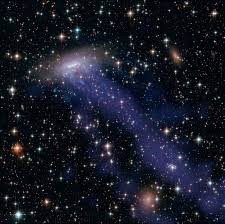Description

Disclaimer: Copyright infringement not intended.
Context
- The Hubble Space Telescope has captured an image of JO201, a jellyfish galaxy in the Abell 85 galaxy cluster.
Details
- The Abell 85 galaxy cluster, is at a distance of about 700 million lightyears, in the constellation of Cetus or the Whale.
- JO201 jellyfish galaxy is located in the region of the sky with water-related constellations, including Aquarius, Pisces and Eridanus.
- Jellyfish galaxies have ‘tentacles’ or tendrils of gas and dust that can trail behind the galaxies for over 300,000 lightyears.
- The material is dragged out of the galaxy through a process known as ram-pressure stripping, as it travels through the intergalactic gas in massive galaxy clusters.
- JO201 was originally a spiral galaxy, and has been moving through the massive galaxy cluster at supersonic speeds, for around a billion years.
- The tentacles of JO201 appear so short because it is moving towards us along the line of sight.
- The ram-pressure stripping is removing reservoirs of gas from the galaxy, pushing it towards extinction, as new forms within the galaxy are formed by the gas in the tendrils.
- However, star formation takes place in the tendrils of the jellyfish galaxies, a process that can be better understood by such observations.
.jpeg)
Jellyfish Galaxy
Galaxy Clusters
- A galaxy cluster, or a cluster of galaxies, is a structure that consists of anywhere from hundreds to thousands of galaxies that are bound together by gravity, with typical masses ranging from 1014 to 1015 solar masses. They are the second-largest known gravitationally bound structures in the universe after galaxy filaments and were believed to be the largest known structures in the universe until the 1980s, when superclusters were discovered. One of the key features of clusters is the intracluster medium (ICM).
- The ICM consists of heated gas between the galaxies and has a peak temperature between 2–15 keV that is dependent on the total mass of the cluster. Galaxy clusters should not be confused with galactic clusters(also known as open clusters), which are star clusters within galaxies, or with globular clusters, which typically orbit galaxies.
- Small aggregates of galaxies are referred to as galaxy groupsrather than clusters of galaxies. The galaxy groups and clusters can themselves cluster together to form superclusters.
- Notable galaxy clusters in the relatively nearby Universe include the Virgo Cluster, Fornax Cluster, Hercules Cluster, and the Coma Cluster.

Basic properties
Galaxy cluster IDCS J1426 is located 10 billion light-years from Earth and has the mass of almost 500 trillion suns (multi-wavelength image: X-rays in blue, visible light in green, and infrared light in red).
Galaxy clusters typically have the following properties:
- They contain 100 to 1,000 galaxies, hot X-ray emitting gas and large amounts of dark matter.
- The distribution of the three components is approximately the same in the cluster.
- They have total masses of 1014 to 1015 solar masses.
- They typically have a diameter from 1 to 5 Mpc (see 1023 m for distance comparisons).
- The spread of velocities for the individual galaxies is about 800–1000 km/s.
|
PRACTICE QUESTION
Q) Which of the following statements is/are correct?
a. Galaxy Clusters have total masses of 1014 to 1015 solar masses.
b. Jellyfish Galaxies are characterised by ram pressure stripping of gas from the affected galaxy by the intracluster medium, triggering starbursts along a tail of gas.
I. Only a
II. Only b
III. Both a and b
IV. Neither a nor b
Answer: Option III
|

https://www.news9live.com/science/hubble-space-telescope-captures-jellyfish-galaxy-jo201-au941-2061898














